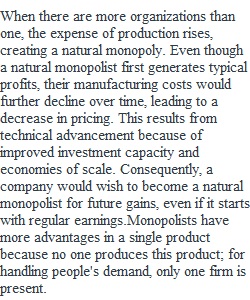


Q Pricing in a Natural Monopoly Click above for Video The Natural Monopoly has Economies of Scale C.3.2.4 Advanced Explanation- Natural Monopoly The Natural Monopoly has a economies of scale in production. The more of the item that is produced, the lower the average total cost (ATC). Energy, Water, Garbage, etc have large fixed costs but lower marginal costs. The more of the product that is produced (garbage picked up) the lower cost. (The garbage trucks are already deployed in the city, picking up the trash of one additional home is a very low marginal cost. Using the Long Run Average Total Cost Curve above for a Natural Monopoly… Which example has the lower cost of producing water? One firm producing 100 gallons or two competitive firms producing and selling 50 gallons each? One Firm producing 100 gallons has an average cost of $15 vs and ACT of $20 by allowing competition. Therefore, it is better to grand ONE firm a Monopoly over the production of water and regulate the market. Below is the City of Palm Springs has the following monopolistic curves for curve for water. Water Wonders is the Natural Monopoly producing water for Palm Springs. Given the data above, Water Wonders offered a bid price of $15 per home to sell water to the average consumer. (Horizontal Axis-Quantity = 1,000's of home-- 2= 2000 and 3=3000) Assumption- water is not scare and can be moved from its source to home by a company with an infrastructure (pipes) to move it. (Natural Monopoly) Homes in Palm Springs pay a flat rate per month for water. The unregulated producer of water would produce water for 2000 homes and charge $20 per month. (Monopoly Price Q=MC=MR-- follow up to price) The regulated producer of water would produce water for 3000 homes and charge $15 per month. (Monopoly Price Q=ATC=D -- ATC=P-- Normal Profit) Look up to the Average Total Cost Curve (ATC). The more water that is produced, the lower the ATC. Hence the regulated Monopolist would be a required to charge the Fair-Return Price and earn Normal Profits . QuickWrite Question: Use the City of Palm Springs and Water Wonders data above. 1. Why would a firm want to become a National Monopolist if they are only making Normal Profits (P=ATC)? 2. Why is it beneficial for a single Natural Monopolist to produce this item (water) rather than have competition> 3. If the City of Palm Springs mandated that Water Wonders produce at a price of $10, would the Natural Monopolist produce the product? Explain. 4. As a natural monopolist (government monopolist- regulated) in exchange for charging a maximum of $15, Water Wonders is the single producer and there are absolute barriers to entry into the market. Water Wonders therefore sells all the water it can at $15. Given this argument, does Water Wonders have an incentive to sell to more than 3000 homes of demand were to shift right? (Look to P>ATC beyond 3000)Explain. 5. What are the benefits to the government and consumers of granting a government (natural) monopoly to a single provider like PG&E, local garbage, water, etc? Need Help? D.1.2.3 Advanced Explanation- Monopolistic Competition Assignment Requirements: This is not an analytical paper, but a summary analysis of your knowledge of the concepts in this chapter. Students ARE NOT to cut and paste from the internet. You are welcome to add cited sources to your response. The response should be about 300 words (one page). Students posting less than a 300 word response will get reduced or no credit. Students may want to construct this response on a Google Doc and then post or submit the item to this portal. These responses are run against public sources via Turnitin.com (running inside Canvas) Submitting an Assignment via Google.Doc. - You can also just paste the text into the box (Links to an external site.) PreviousNext
View Related Questions